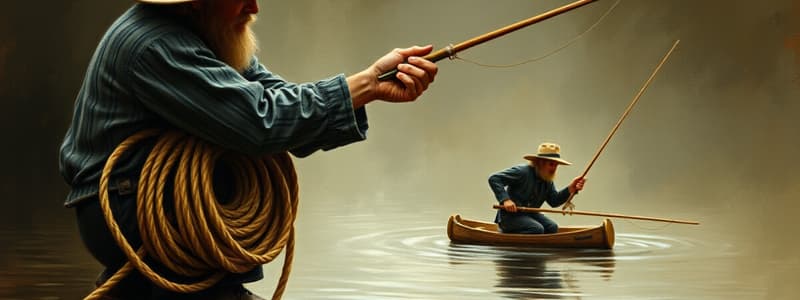Podcast
Questions and Answers
Which knot is used to secure the bitter end of a ladder when taking a wrap around the beams?
Which knot is used to secure the bitter end of a ladder when taking a wrap around the beams?
- Bowline knot (correct)
- Clove hitch
- Square knot
- Half hitch
What technique should be used to tie securely with barrels, sacked or boxed items?
What technique should be used to tie securely with barrels, sacked or boxed items?
- Tying a clove hitch
- Employing an overhand knot only
- Using a barrel knot (correct)
- Utilizing a square knot without tension
When securing a portable extinguisher, how many half hitches are recommended?
When securing a portable extinguisher, how many half hitches are recommended?
- Two at the middle
- Only one at the top
- One near the bottom
- One at the middle and one near the top (correct)
What is the primary use of a clove hitch near the small end of a bar?
What is the primary use of a clove hitch near the small end of a bar?
Which knot is used in the hose roller technique for joining two lines?
Which knot is used in the hose roller technique for joining two lines?
What is the purpose of a half hitch when tying a knot around the nozzle tip?
What is the purpose of a half hitch when tying a knot around the nozzle tip?
How is a bowline used in conjunction with the ball and chain technique?
How is a bowline used in conjunction with the ball and chain technique?
What is an important feature of the square knot when joining two lines?
What is an important feature of the square knot when joining two lines?
What is the purpose of tying a running bowline on the first coupling above the strainer when securing hard suctions?
What is the purpose of tying a running bowline on the first coupling above the strainer when securing hard suctions?
When utilizing droplines for raising small hand lines aloft, where should the loop be placed on the hose?
When utilizing droplines for raising small hand lines aloft, where should the loop be placed on the hose?
What knot is formed using two half hitches tied on the fourth rung in the Bangor Ladder Knot?
What knot is formed using two half hitches tied on the fourth rung in the Bangor Ladder Knot?
What is the recommended diameter for coils when preparing a rope for throwing?
What is the recommended diameter for coils when preparing a rope for throwing?
Why is it crucial to remove the dropline prior to advancing the hose once it reaches the desired landing?
Why is it crucial to remove the dropline prior to advancing the hose once it reaches the desired landing?
What is the function of a clove hitch when securing hard suctions?
What is the function of a clove hitch when securing hard suctions?
In coiling rope for throwing, what size should the smaller coils be at the end?
In coiling rope for throwing, what size should the smaller coils be at the end?
What is the primary advantage of using dropline techniques when raising hoses in multi-storied structures?
What is the primary advantage of using dropline techniques when raising hoses in multi-storied structures?
What is the primary purpose of using small coils when casting a line?
What is the primary purpose of using small coils when casting a line?
How far can a line typically be cast using the coiling technique?
How far can a line typically be cast using the coiling technique?
What is a key advantage of coiling rope before throwing it?
What is a key advantage of coiling rope before throwing it?
What does the Running Bowline technique primarily achieve?
What does the Running Bowline technique primarily achieve?
When casting a line, what should be considered to maintain safety?
When casting a line, what should be considered to maintain safety?
What technique is important to prevent tangles when coiling rope?
What technique is important to prevent tangles when coiling rope?
What is the correct way to use large coils when casting a line?
What is the correct way to use large coils when casting a line?
Which of the following best describes coiling techniques?
Which of the following best describes coiling techniques?
What is a common mistake when throwing ropes?
What is a common mistake when throwing ropes?
Which knot is specifically designed to create a secure loop that can be adjusted?
Which knot is specifically designed to create a secure loop that can be adjusted?
Why is proper coiling of rope important in safety practices?
Why is proper coiling of rope important in safety practices?
What characteristic makes the Running Bowline knot versatile?
What characteristic makes the Running Bowline knot versatile?
Which factor is NOT critical to consider when coiling rope for throwing?
Which factor is NOT critical to consider when coiling rope for throwing?
What is a key benefit of understanding various knot techniques?
What is a key benefit of understanding various knot techniques?
Flashcards are hidden until you start studying
Study Notes
Coiling and Throwing Rope
- Use small coils to throw toward an objective, allowing large coils to either pay off from the ground or the other hand.
- Small coils provide the necessary weight to carry the line to a designated point; with practice, distances up to 50 ft can be achieved.
- For throwing, create coils about three feet in diameter, leaving enough free end to form four or five smaller coils approximately 18 inches in diameter.
- Bind small coils using a bight, and secure with a half hitch around the nozzle tip.
Knot Techniques
- Bangor Ladder Knot: Composed of two half hitches with a bight tied on a rung; it secures the hanging part of the halyard.
- Securing Hard Suctions: Use a clove hitch at the bottom next to the strainer and a running bowline on the first coupling above the strainer to relieve strain on couplings.
- Small Hand Lines Aloft: Utilize drop bag lines for raising small lines in multi-storied structures; form a loop from a bight in the running line to attach to a hose.
- Two methods to send small lines aloft:
- Place a loop behind the coupling with an added half-hitch.
- Create a 12-inch loop with an overhand knot and run it through the shut-off bale.
Various Knots for Specific Tools
- Axes and Sledge: Use a running loop over the head of the tool and a half hitch near the end of the handle.
- Bars (Crow and Jumbo): Secure with a clove hitch at the small end and a half hitch below the shoulder on the large end.
- Portable Extinguishers: Use a clove hitch around the base, and secure it with half hitches in the middle and top region.
- Barrels and Boxed Items: Use a barrel knot, placing the object on the running line and securing with an overhand knot.
- Ladders: Wrap below the proper rung, securing with a bowline knot. For roof ladders, wrap below the third rung from the top.
Joining Two Lines
- Use a Beckett bend for joining two lines; for lines of equal size, a square knot can be employed, though it is not recommended for lines of unequal thickness.
- A hose roller knot combines several techniques: a bowline with a bight, overhand knot with a bight, and a half hitch.
- Ball and chain connection can be established using a bowline through the ring on the chain, complemented by a clove hitch around the chain above the ball.
Studying That Suits You
Use AI to generate personalized quizzes and flashcards to suit your learning preferences.




